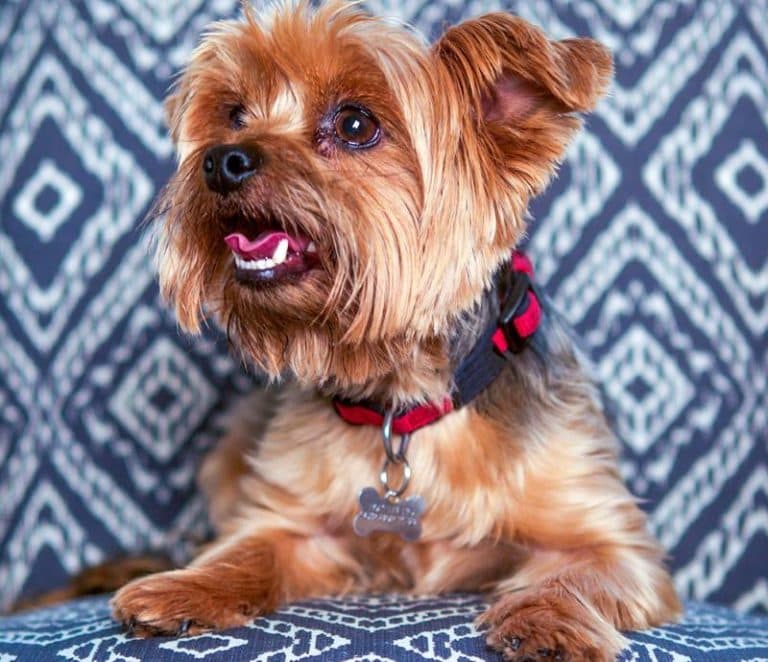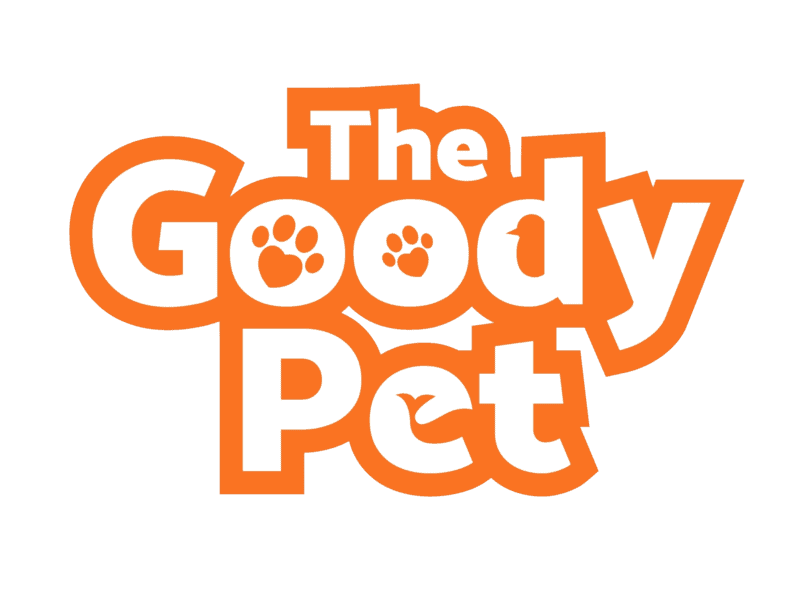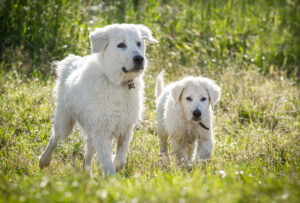Yorkies are small, feisty and loving dogs that make great companions for both children and adults. They’re loyal and affectionate, and they have a lot of personality packed into their small frames. But what does a Yorkie look like?
Traditional Yorkshire Terriers have a mix of color pairs (Black & Tan, Black & Gold, Blue & Tan, Blue & Gold) from the back of their necks down to the base of their tails. Its head, chest and legs bear a contrastingly vibrant rich tan color. Yorkies are about 8 to 9 inches in size and weigh between 4 to 7 lbs.
As Yorkie puppies mature into adults, they do undergo a drastic change in color too. Their coat lightens, usually changing from a darker color at birth to a lighter color upon reaching adulthood.
What Does A Yorkie Look Like?
Yorkshire Terriers are best known for their small, compact builds. They fall in the American Kennel Club toy breed category.
At their largest, Yorkshire Terriers can weigh up to 7 lbs and measure 8 to 9 inches in height.
These little fiery balls of energy are proportionate in terms of weight for their size which sets them apart from other toy breeds.
There is probably nothing as endearing as a Yorkie’s cute little face. They have very characteristic head and facial features including a flat head top, short nose, and prominent, pointy ears. Their eyes are also very unique with their large, dark, and beady design that makes the pooches even cuter.

Another stand-out feature with traditional Yorkies is the perky tail that distinctively perks up above the level of the back. They can measure up to 5 inches at full, undocked length. However, for the sake of aesthetics and regional show dog competition rules, a lot of Yorkies have shortened tails usually between 2-4 inches.
The limbs are also a quintessential part of the Yorkie’s iconic aesthetic. They have short and straight legs that are for the most part pretty unremarkable. Something pretty cool however is the fact that they have all black toenails.
Finally, you could spot a Yorkie by their coat. They are popular for their thick and silky fur which is typically allowed to grow out. They allow for Yorkie owners to love to give their Yorkies teddy bear cuts to evoke the overflowing cuteness of their pet.
When it comes to color, on the other hand, the coats are quite versatile. Traditional Yorkies have dark backs and tan or gold heads, chests, and legs.
Are There Different Types Of Yorkies?

There are many different variations within the Yorkshire Terrier family. These differences are mainly based on breeding, coat character as well as size. Here are 8 of the most recognizable types of beloved little doggies:
Traditional Yorkshire Terrier
These Yorkies are your typical 8-inch, 7-pound hairy little beauties. Their color distribution, size, proportionality, and long hair are what set them apart from all the other types of Yorkies.
Biewers Terriers
Biewers stand out with their unique coat colors. Unlike the strict 3-color pattern on traditional Yorkies, this type features additional random streaks of white fur all over their body.
Teacup (Miniature) Yorkies
Teacup Yorkies are different from traditional Yorkies only when it comes to size and are a result of breeding runts. They do not exceed 3 lbs in weight and are generally among the most popular teacup dog breeds.
Mismarked Yorkies
This is yet another variation based on coat colors. Mismarked Yorkies are generally any dogs in the breed whose coat colors do not conform to the American Kennel Club standard for Yorkies.
Parti Yorkies
The defining feature with Parti Yorkies is the presence of patches of white fur all over the body in addition to the traditional black and tan combinations.
Golden Yorkies
Also known as gold dust Yorkies, this type of Yorkshire Terrier has golden or tan fur all over its body. For a Yorkie to fall into this category, there should be no black fur patches.
Black Yorkies
These beauties have uniform black fur all over their bodies that slowly transitions to a dark blue and tan combination as they grow older. These are usually very rare and are, more often than not, a result of interbreeding.
Yorkie Mixes
This type consists of Yorkies with multiple breed genes as a result of interbreeding. The appearance is usually determined by the specific mating dogs. They are sometimes referred to as mutts.
Purebreds And Mutts: How Do I Know If My Yorkie Is Full Blooded?

Speaking of mutts, one of the biggest challenges potential owners have is distinguishing between mixed Yorkies and purebred breeds. It is not likely that you will get your hands on a purebred if you are rescuing a Yorkie from a dog shelter for free. However, knowing how to differentiate will come in important if you are getting it from a breeder.
The differences depend largely on the type of dog used in the breeding. The closer they are in size and appearance the more difficult it is to tell the difference.
However, there are always several clues that will give you an idea of what you’re dealing with. These include:
The Color Is Always A Giveaway
The closer the Yorkie is to the traditional color distribution the more pure the bloodline is. Variations like Black Yorkies, goldies, and partis are usually results of breeding with other dogs that have their distinct coat color combinations. The resulting pups take on coloring genes from both parents for a unique variant to the traditional black/blue and gold/tan combo.
Size Matters
Size is another dead giveaway for interbreeding when it comes to Yorkies. The breed generally sticks within the 4 to 7 lbs and 8 to 9 inches size ranges. When mixed with larger dog breeds, the resulting mutt tends to be larger and heavier than your typical Yorkie. Smaller ones on the other hand are usually purebred from small Yorkies.
Temperament Variations
Your dog’s personality could also tell you whether or not your Yorkie is purebred or mixed. Purebred Yorkies are known for their small body-big personality temperament. They tend to be livelier, fussier, and generally more social. Mutts on the other hand are often more laid back, easier to handle, and bark less. This is, of course, assuming they are mixed with a calm breed, and not yet another aggressive breed to make it double trouble!
Health Problems
One of the main benefits mutts have over purebred Yorkies is their better health. Mixing the genes breeds out anomalies that ail the purebred pooches. If you find yourself with fewer vet visits than you expected plus all the other clues discussed you are probably dealing with a mixed Yorkie.
How Big Do Yorkies Get?

Yorkies are in the toy breed category when it comes to size. At their peak, they range in size between 8 to 9 inches and weight between 4 to 6 lbs.
This, however, may vary depending on several factors like:
Nutrition
Yorkie growth is tied to what and how much they eat. As a small breed type of dog, they are prone to health problems like obesity. Their wild appetite does not help matters and if uncontrolled, the Yorkie can very easily grow larger than is healthy for their structure.
Fitness Level
It is all about calories in and calories out. If for some reason your dog does not get to play enough or plays more than they eat, they are likely to fall out of their normal size range as far weight is concerned.
Purity Of The Breed
More often than not, mixed Yorkies do not stay within the size limits of purebreds. This is particularly the case when they are mixed with larger breeds. Some can get as heavy as 25 lbs as is the case with Yorkie-beagle mixes.
Genetics
Even within purebred Yorkies, there are some variations in size. The best example is that of teacup Yorkies which often do not grow past the 3-pound mark. These are the same in terms of genetics with traditional Yorkies but for congenital reasons do not thrive as far as physical growth is concerned.
Health Status
Finally, the health status of the Yorkie determines how large they get. Sickly doggies often suffer stunted growth as a consequence of long-term ill-health. Sometimes, the condition directly causes stunted growth, whether it is bone problems or malnutrition due to constant vomiting and diarrhea.
From Feeding To Grooming: Are Yorkies High Maintenance?
Yorkies are notoriously high-maintenance despite being so small. Although they might sleep a lot and require less of your time, everything from their personalities to their health tendencies often needs a little more tender loving care than other breeds. Here are some of the key maintenance factors you will have to deal with.
They Need High-Quality Diets
This is the main cost you have to deal with when it comes to raising a healthy Yorkie. These little beasts love to eat. They also have very delicate guts. It is therefore about a balance between quantity and quality.
Nulo Small Breed Dog Food is a popular option among Yorkie owners. The highly filling grain-free dog food stands out with the high protein and low carb formula which is ideal for the obesity-prone small breed.
If you have a fussy eater on your hand, try the TOMLYN High Calorie-Nutritional Gel. This ensures they have a decent supply of calories and nutrients even if they are not eating as much as they should.
You can use it in the form of dog treats and feed them outside mealtime to keep their sugar level high. Doing so will prevent hypoglycemia, a common illness among Yorkies that can lead to shaking and vomiting.
Regular Grooming Is Unavoidable
The coat of Yorkies tends to grow very long and thick very fast. Although they do not shed as much, regular grooming remains an inevitable expense unless you want your pooch tripping over long fur or getting blinded by the thick mane. Poor grooming practice also breeds bad hygiene and it can cause your pooch to smell bad.
You could save some money by doing it yourself. Just invest in great tools like the Pet Magasin Grooming Shears. The stainless steel scissors are built with your pooch’s safety in mind with their curved end feature. That way whether you are trimming their face coat or the rest of the body, you don’t have to worry about hurting the little one.
They Have Several Health Needs
Another cost you will incur maintaining these little ones is vet bills. In addition to your routine shots and checkups, you might have to regularly fork out cash for specific Yorkie problems. These range from genetic defects to dental problems and even infections.
As they have a very small body build, it is can be life-threatening for them to be holding a baby in them throughout the pregnancy. If you do not intend for your Yorkie to have litters, which can be exponentially more troublesome to take care of, you will need to take into account the cost of neutering to prevent them from entering the heat cycle.
You Can Put A Price On Fun
It takes a lot of creativity to keep needy Yorkies adequately entertained. You will have to invest in toys which is an additional cost to factor in. To save money, just buy high-quality toys that will last long so you do not have to keep replacing them.
Training Requirement
Fortunately, Yorkies are generally smart dogs. They are intelligent and are fairly easily trained even as puppies. Ranked as the 34th most intelligent dog breed by Stanley Coren, no wonder potty training and tricks learning will be such a breeze for them.
Related Questions
Why Do Yorkies Turn Gray? Yorkies contain a specific graying gene. This continually lightens the color of their coats as they get older. At first, black patches turn light and may even appear blue depending on other genetic factors. Eventually, as they enter their elderly years, the gene causes their skin and patches of fur to turn gray.
At What Age Do Yorkies Change Color? You may start to notice changes from darker tones to lighter variations when Yorkies are around 6 months old. It is not until Yorkies are between 12 to 18 months that their adult coloring sets in. Change in their coat color is a continuous process unique to every single Yorkie.
How Can You Tell How Old A Yorkie Is? It is not very easy to determine the specific age for a Yorkie. However, some clues could give you a rough estimate of their age group. One way to estimate a Yorkie’s age is through their size. Yorkies usually reach their optimum weight and height at around 18 months. The fur color could also indicate their age. The darker they are the younger their age for traditional Yorkies. Finally, you could look for specific complications of old age like dental issues and cataracts.





